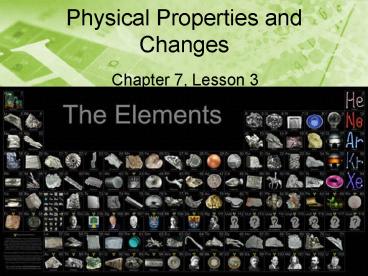Physical Properties and Changes - PowerPoint PPT Presentation
1 / 16
Title:
Physical Properties and Changes
Description:
Physical Properties and Changes Chapter 7, Lesson 3 What is a physical property? A physical property is any characteristic of a material that can be observed without ... – PowerPoint PPT presentation
Number of Views:217
Avg rating:3.0/5.0
Title: Physical Properties and Changes
1
Physical Properties and Changes
- Chapter 7, Lesson 3
2
What is a physical property?
- A physical property is any characteristic of a
material that can be observed without changing
the identity of the material itself such as
color, shape or length. - Some physical properties, such as mass and
volume, depend on the amount of matter other
physical properties do not depend on the amount
of matter.
3
Physical Properties
- The temperature at which a solid changes to a
liquid is its melting point. This does not
depend on the amount of matter. - The temperature at which a liquid changes to a
gas is its boiling point. This does not depend
on the amount of matter.
4
Physical Properties (contd)
- Attractive forces determine the melting and
boiling points of a substance. - Molecules with weak attraction have low melting
and boiling points. - Molecules with strong attraction have high
melting and boiling points.
5
Physical Properties (contd)
- Pressure also affects the boiling point
- The higher the air pressure, the higher the
boiling point.
6
Physical Properties (contd)
- Density is a physical property of a substance
that does not depend on the amount of matter. - Density is the mass-per-unit volume of a
substance. - A substances density is higher when its
particles are packed more tightly together. - D
7
Physical Properties (contd)
- Hardness is a physical property that shows how
strongly the particles of a substance are held
together. - Diamonds are a form of carbon and are the hardest
substance found in nature.
8
Physical Properties (contd)
- The table below shows the difference between the
structure of diamonds and graphite, both of which
are forms of carbon.
9
Physical Properties (contd)
- Thermal conductivity is the ability of a material
to transfer heat. - When one part of a metal is heated, the particles
collide into other particles and the heat is
transferred throughout.
10
Physical Properties (contd)
- Electrical conductivity is the ability of a
material to transfer electric charge.
11
What is a physical change?
- A physical change is any change in size, shape,
or state of matter in which the identity of the
substance is not changed. - Dissolving is a physical change in which one
substance is mixed into another substance to form
a solution. - Mixing is a physical change that takes place when
two substances are combined and neither substance
dissolves.
12
What is a physical change? (contd)
- Changes in the state of matter of a substance are
physical changes and are reversible - Melting and freezing
- Boiling and condensing
- Subliming and deposing
13
What is a chemical change?
- In comparison, a chemical change is the change of
one or more substances into other substances. - A chemical change can not be reversed
- Burning paper ash, CO2, H2O
- Baking soda vinegar CO2, H2O
- Rust FeO (iron oxide)
- (more to come in Chapter 8)
14
7-3 Lesson Review Questions
- 1) When water changes to ice, it is undergoing a
____. - A chemical change
- B physical change
- C radioactive decay
- D metallic change
15
7-3 Lesson Review Questions
- 2) Which of the following is NOT a physical
change? - A ice melting into water
- B sugar dissolving into water
- C sand and sugar mixing
- D burning a candle
16
7-3 Lesson Review Questions
- 3) Which of the following is NOT a physical
property? - A density
- B conductivity
- C hardness
- D all are physical properties

